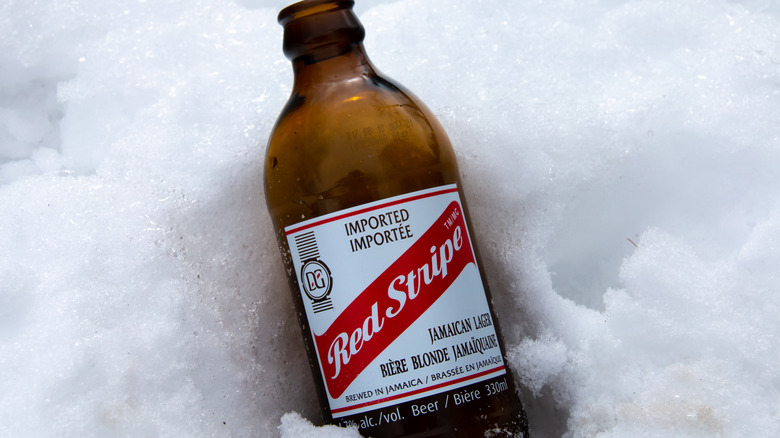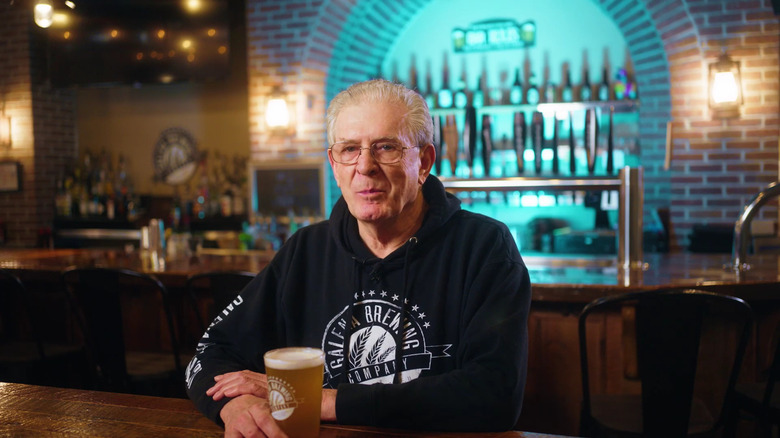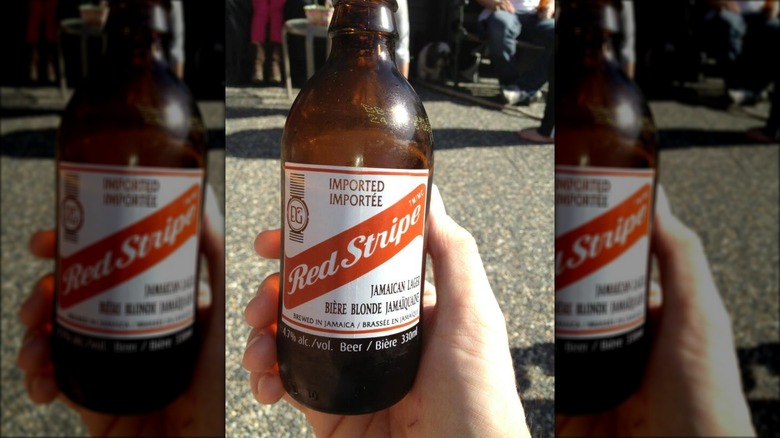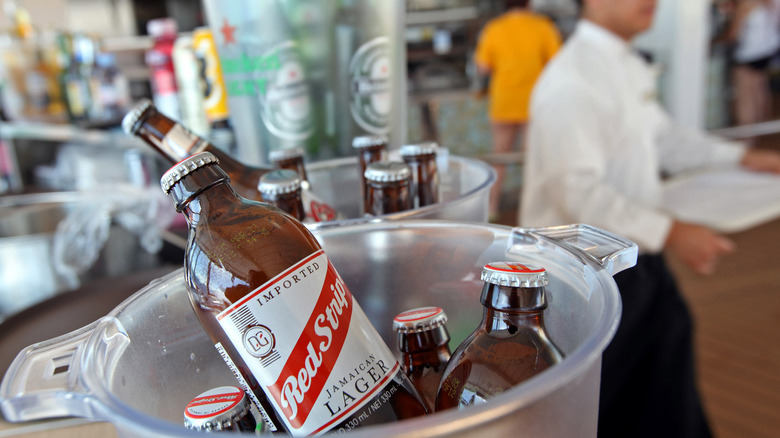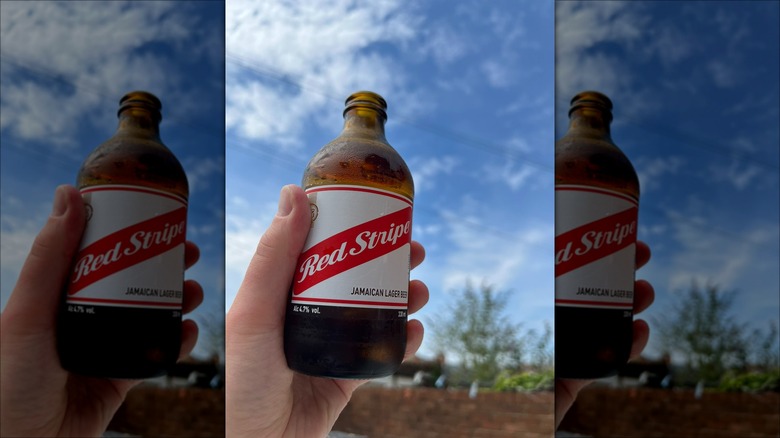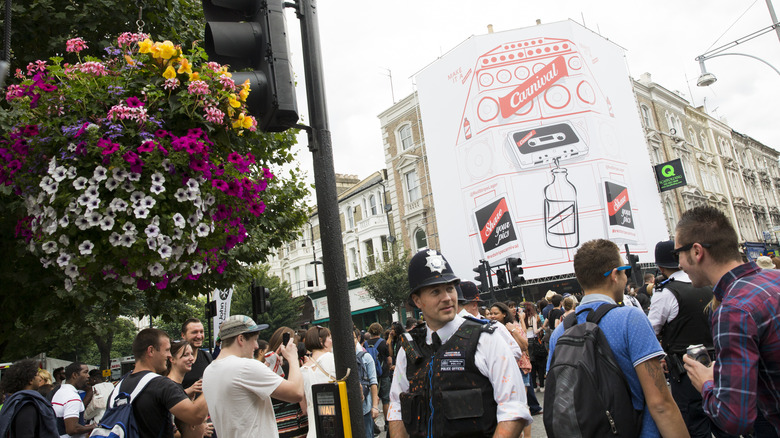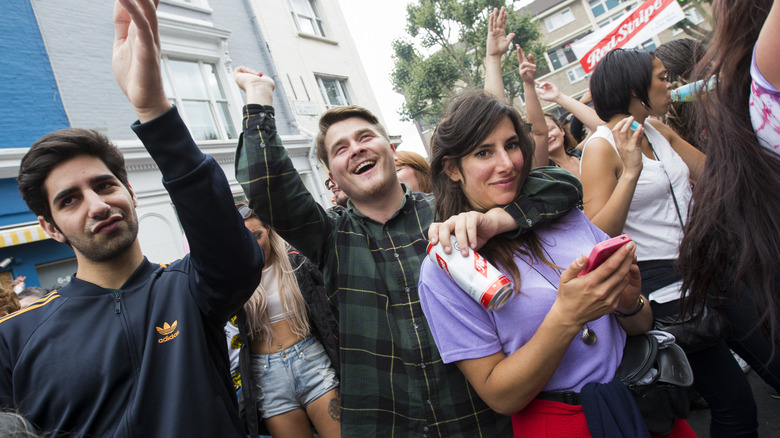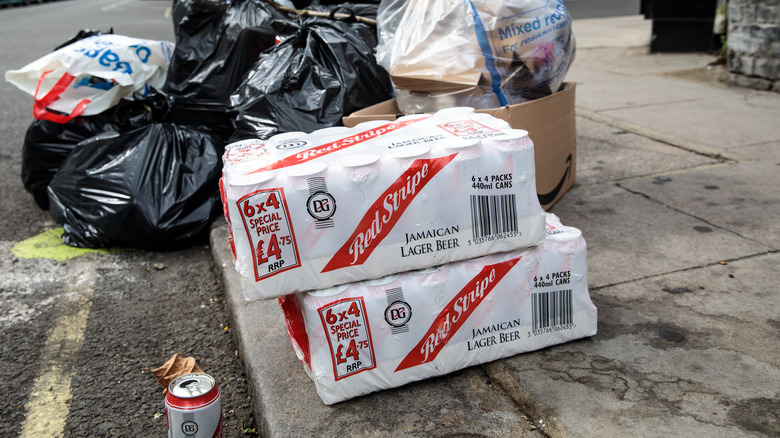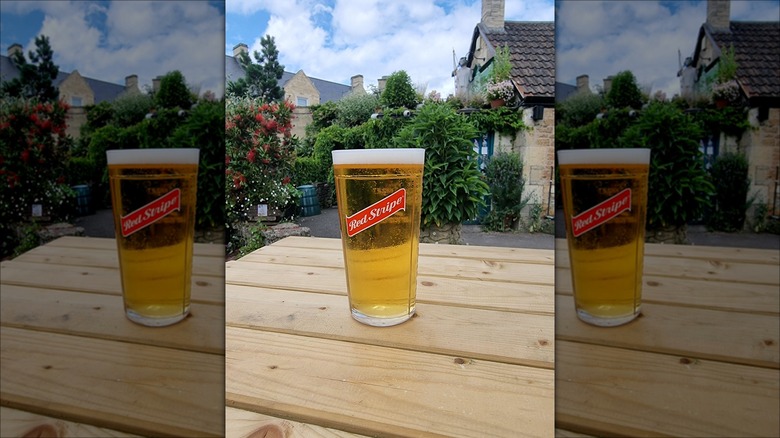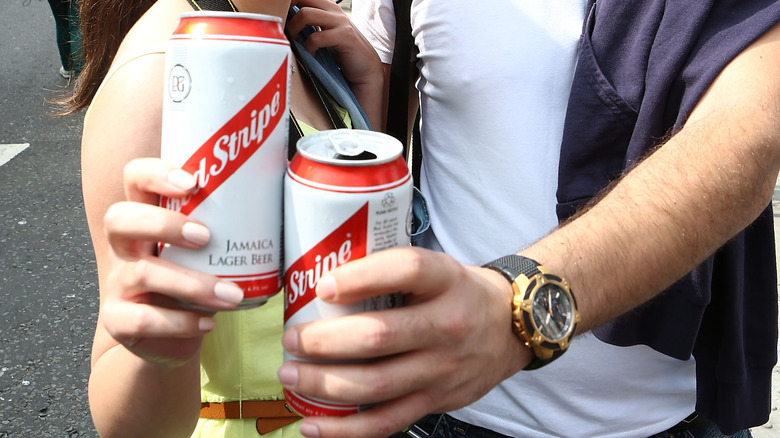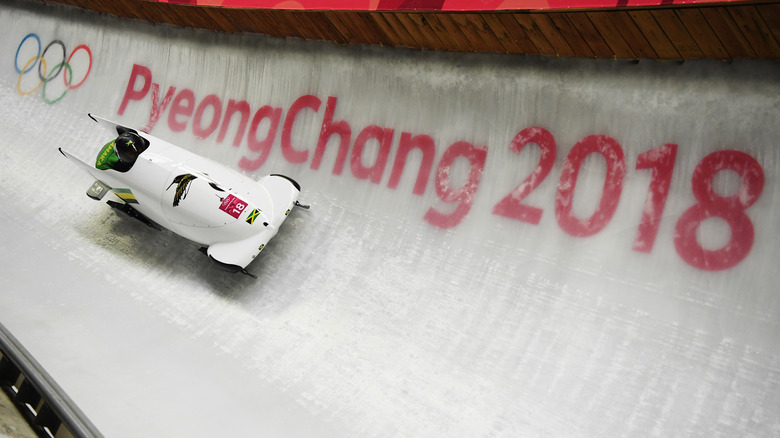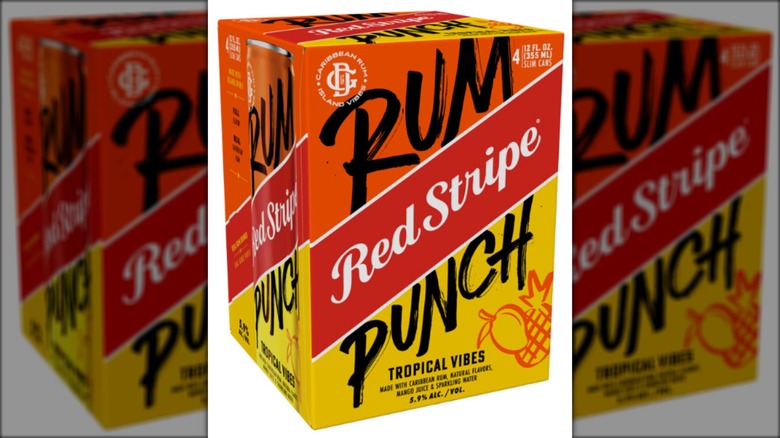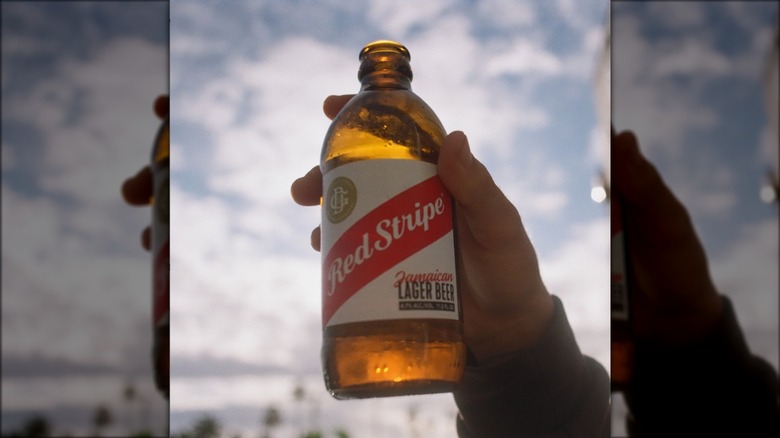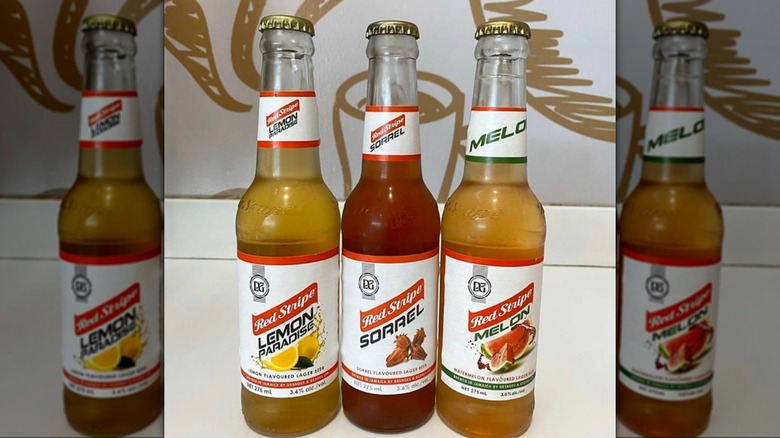13 Things You Need To Know About Red Stripe
The instantly recognizable Red Stripe cans and bottles are a ubiquitous feature of clubs and bars across the globe. In the U.K., Red Stripe is often enjoyed at indie rock concerts. In the United States, Red Stripe is enjoyed by those who might also reach for Pabst Blue Ribbon and, much like PBR, Red Stripe was incredibly popular during the early 2000s. In fact, the light, pale lager remains America's most imported Caribbean product.
There's no lack of pale, light beers brewed domestically, begging the question why so many Americans choose to drink a beer that's produced in Jamaica. The beer's low price point, simple flavor, and dependable nature undoubtedly play a part in this decision. However, Red Stripe's biggest strength seems to be the company itself and the identity it's created over the past decades. As with any large company, developing and maintaining this has been one of Red Stripe's greatest challenges. Here, we provide a deeper dive into how Red Stripe built its distinctive identity and reveal what's really behind that oft-reached-for can.
1. Red Stripe's Jamaican origins are disputed
Ask any beer drinker where Red Stripe is from and they will instantly say "Jamaica!" Thanks to decades of Jamaica-centric advertising, this is something people who don't even drink beer could probably tell you. But while Red Stripe is currently brewed in and closely associated with Jamaica, there are some people who believe the beer itself was actually invented in Galena, Illinois.
Warren Bell, the current owner of The Galena Brewing Company is one such person. In an interview with WQAD 8, he said, "Even though Red Stripe's considered a Jamaican beer and enjoyed all over, its origin was a Galena label and it was a Galena label for 100 years before it went to Jamaica." This is not a proven fact, although Galena Brewery — which was founded in 1886 when Casper Eulberg took over the premises of a longstanding brewery — was known to produce a lager that was called Red Stripe.
The Red Stripe we drink today is produced by Desnoes and Geddes, a company that was launched by two British businessmen Eugene Desnoes and Thomas Geddes in 1918. A version of Red Stripe was first produced by Desnoes and Geddes during the 1920s. Supporters of the Galena theory believe that, at some point, Desnoes and Geddes purchased Galena Brewery's recipe for Red Stripe. Whether this is true or not cannot be confirmed, but many people in Galena still champion the beer as their own.
2. Red Stripe was first brewed in Jamaica in 1928
When founded in 1918, Desnoes and Geddes was focused on the production of non-alcoholic drinks. In fact, the company still produces some soft drinks including the widely enjoyed Old Jamaica Ginger Beer. In 1928, Desnoes and Geddes started brewing Red Stripe although this version of the beer was nothing like the Red Stripe we enjoy today. Instead of being a light lager, this early iteration of Red Stripe was a strong, traditional British ale. This heavy style of beer proved a poor fit for Jamaica's hot climate and sales were underwhelming.
The founder's sons Paul Geddes and Peter Desnoes played a prominent role in Desnoes and Geddes until they took it over in 1938. Four years before the change in ownership, Geddes and another man called Bill Martindale took this opportunity to completely rework Red Stripe, transforming it from an ale to a refreshing lager. This beer was much better received by the public and proved so popular that the British government attempted to implement an excise tax on it, to make up for the losses it was incurring for English ales. Due to protests, the proposed tax was never enforced.
3. It developed its trademark taste in Jamaica
The recipe that Paul Geddes and Bill Martindale perfected in Jamaica during the 1930s is the one still used today. Unlike the dark ale that preceded it, this golden lager is defined by a crisp, slightly hoppy flavor. Full-bodied and smooth, thanks to low levels of carbonation, this beer is immensely refreshing to drink, making it a good match for warm Jamaican weather. A slightly sweet aftertaste ensures it's decidedly moreish.
Red Stripe is a mass-produced beer. This means many craft beer enthusiasts refuse to drink it. Those that do, however, generally concede that it is a decent beer — one that's superior to other mass-produced products such as Bud Light. A review posted to Beer Advocate highlights this, saying, "Pretty typical beer aroma of sweet corn and malts, heavy undertones of that butterscotch described. The body's pretty much all the same, a bright, refreshing wave of sweet corn, butterscotch, and melon. It's simple and straightforward and a pretty good macro."
4. Red Stripe went international after World War Two and Jamaican independence
During World War Two many Canadian and American troops were stationed in Jamaica. These individuals soon developed a taste for local products, including Red Stripe which had yet to be exported to either country. The huge influx of young men to Jamaica saw domestic sales of Red Stripe shoot up. These boosted sales ultimately contributed to Desnoes and Geddes' decision to build a new brewing complex on Spanish Town Road — a complex that's still in use today.
Thanks to the expansion, Desnoes and Geddes could produce more Red Stripe than ever before. Jamaican independence, when it came in 1962, further aided the brand by allowing it to fully lean into Jamaican culture and national identity. These factors paved the way for the business to start exporting the beer.
Red Stripe was first exported to the U.K. in 1976, and proved so popular that it was soon contract brewed in the country. In 1985, Red Stripe became available in the U.S., although sales were initially poor. These improved once Red Stripe was packaged in its iconic, brown "stubby" bottles.
5. Red Stripe cultivated a distinct image
During the early 2000s, Red Stripe began a concerted effort to increase export sales, especially in the United States. A new, innovative marketing strategy was required to achieve this. While Red Stripe decided to pursue traditional advertising mediums such as commercials, it did so in a unique way, eschewing the competitive, masculine ads associated with beers like Bud Light in favor of ones with a more laid-back feel.
As a key character in many of these commercials, The Red Stripe Ambassador was vital to this strategy. The marketing team decided against hiring an actor for the role in an effort to make the commercials as authentic and relatable as possible. While not outlandish, this approach was different, which all but guaranteed its success. Speaking to VinePair, creative director Gerry Graf explained, "I knew it would be successful because at the time very few beer brands were doing anything new or original. Budweiser was doing really boring stuff. Bud Light was OK, but doing broadly funny stuff. We felt we could make Red Stripe the cooler, edgier choice."
Aside from commercials, Red Stripe also connected with its audience by sponsoring various sporting and music events. These included cricket matches, surf competitions, and festivals, such as Notting Hill Carnival. The strategy paid off; in 2005, Red Stripe's exports outstripped domestic sales for the first time in the company's history.
6. Red Stripe is tied to the U.K. music scene
Red Stripe has strong associations with music culture, and these associations are keenly felt in the United Kingdom where Red Stripe has long been linked with rock music. As brand manager Jonathan Kirkham highlighted to Marketing Week, "From the 1980s when it was drunk by The Clash through to the 1990s when it appeared on an Oasis album cover being drunk by Noel Gallagher, Red Stripe has a long association with creativity and music." Aside from being a beer favored by rock legends, Red Stripe also became associated with British rock because it was a cheap beer stocked by some of Britain's biggest rock venues, including London Astoria.
Over the years, Red Stripe has further strengthened its associations with British music by sponsoring a host of music events and awards. Most notable of these was the Red Stripe Music Awards which granted winning acts the opportunity to play at two major British festivals. Run between 2007 and 2010, the award championed many new musicians including a young Ben Howard.
Nowadays, Red Stripe is more closely associated with Britain's underground music scene, especially in cities like Glasgow that have a large student population. This is an indication that Red Stripe's low price and music-associated image make it the de facto drink of choice in Britain's clubs regardless of what type of music is being played.
7. Guinness bought a majority in Red Stripe in the '90s
In 1993, it was announced that Guinness was paying $62 million to become the majority shareholder in Red Stripe. With this controlling stake, Guinness wielded great control over Red Stripe's operations. Initially, the company used it well; access to Guinness' wealth and distribution network is thought to have played a key role in Red Stripe's growing global popularity during the early 2000s. Then, due to a merger in 1997, Guinness became Diageo. It was this company that decided to move the production of Red Stripe from Jamaica to a brewery in Pennsylvania in 2012 — a bold move that did not pay off.
Instead of boosting sales, this move saw a class-action lawsuit, which claimed the beer was being deceptively marketed, being filed against Diageo in the summer of 2015. The lawsuit stated that Diageo's use of phrases like "Jamaican Style Lager" led people to believe the beer was still being made in Jamaica with Jamaican ingredients. All claims were later dismissed, but Diageo's association with Red Stripe did not last much longer. In October 2015 Diageo announced it was selling its 57.87% stake in Desnoes and Geddes to Heineken.
8. Heineken brought Red Stripe back to Jamaica
After purchasing Red Stripe, Heineken wasted little time in moving production back to Red Stripe's original facility in Jamaica. This move was slated to create 300 jobs for the country and news of the move was enthusiastically received by Jamaica's former minister of industry, Anthony Hylton. In an interview with Jamaica Information Service Hylton said, "This is such a wonderful project representing a vote of confidence in Jamaica and its possibilities [...] It is testament, first of all, to the first-class work habits and talents of the Jamaican workers that are here at Red Stripe, that we can capture the market globally."
Aside from moving Red Stripe's production back to Jamaica, Heineken also invested $16 million in an effort to increase production and boost ailing export sales. Unfortunately, these investments have not restored Red Stripe to its former glory. The brand has continued to lose ground to other imports, especially beers from Mexico. According to YouGov, now only 63% of Americans are familiar with the brand.
9. Red Stripe bounced back after the Coronavirus impacts
Despite Red Stripe's struggles, the brand is not throwing in the towel. In fact, it's committed to a $2.2 billion cellar expansion which stands to increase beer production by an impressive 34%. The reason behind such a large investment is simple — Red Stripe has performed well since the Coronavirus pandemic abated.
After touring the facilities, current minister of industry Aubyn Hill said to Jamaica Information Services, "They have a line that is running 24 hours to make stout and beer and other products for their markets. When you look at their sales, they have improved and, in fact, they are now beyond the pre-pandemic numbers."
This expansion is geared towards increasing Red Stripe's export numbers. Currently, the brand exports just over a quarter of its total production, a far cry from the more than 50% the brand achieved during the mid-2000s. Aside from upping export sales, the development includes steps to improve the plant's environmental sustainability and is slated to significantly reduce tanks' usage of energy, water, and chemicals.
10. Red Stripe supports Jamaican sports
Red Stripe is proud of its Jamaican origins and frequently finds ways to give back to the country. One means it has found is supporting Jamaican sport, most notably the Jamaican Olympic Association. In December 2023, it was announced that Red Stripe partnered with the JOA, donating $80 million to help athletes prepare for the upcoming Olympic Games in Paris.
This is not the first time Red Stripe has stepped in to support Jamaican Olympians. During the 2018 Winter Olympics held in Pyeongchang, South Korea, the women's Jamaican bobsled squad was suddenly left without a bobsleigh after their coach Sandra Kiriasis left the team. Kirasis had loaned the sleigh in her own name, so was unwilling to part with it unless she was paid. After hearing the news, Red Stripe stepped in and wired $50,000 to Kirasis' account. This allowed the two-woman team of Jazmine Fenlator-Victorian and Carrie Russell to become the first female bobsledders to represent Jamaica at the Olympics. They placed 18th, just a tenth of a second behind Austria.
Red Stripe has also supported many athletes outside of the Olympics. In 2021, for example, Red Stripe paid the football team Humble Lions $500,000 to support the team in its nutritional and technical fields.
11. The brand now produces canned rum cocktails
Although best known for its eponymous lager, Red Stripe is attempting to branch out by selling two ready-to-drink canned cocktails — Red Stripe Rum Punch and Red Stripe Rum Mojito. This is a response to the increasing popularity of RTD canned cocktails; during 2021 the sector saw a 42% increase in revenue, with many of the purchasers transitioning to RTD cocktails after leaving the declining hard seltzer market. Both of Red Stripe's new products are made with Caribbean rum and are available internationally. However, some people have questioned how well they fit into Red Stripe's brand identity.
Aside from selling well, senior members are hoping that the RTD canned cocktails will drive more customers toward Red Stripe's famous larger. As Heineken USA's chief marketing officer Jonnie Cahill explained to VinePair, "With the launch of the Rum Drinks we'll be recruiting new consumers in higher energy occasions while increasing total awareness and adoption for brand Red Stripe, including Lager [...] Growing lager continues to be a high-level priority for Red Stripe."
12. Red Stripe is part of Jamaican culture
After being associated with the country for over a century, it's no surprise that Red Stripe has become a valued part of Jamaica's culture. Speaking to Jamaica Information Service, Red Stripe senior Sean Wallace explained, "Throughout our 104-year history, we have remained at the epicenter of all things Jamaican. [...] Our iconic beer is synonymous with Jamaica. When you think of authentic Jamaican culture and experiences, a cold Red Stripe beer is always present."
Most recently, Red Stripe's association with Jamaica was reinforced by the beer's inclusion in "Bob Marley: One Love", a feature-length film about the famous reggae musician. This is because, as production executive Mathew Ferrante has highlighted, Red Stripe was and is an integral part of Jamaican life. As such, failure to include the beer in the movie would simply be inaccurate. Of course, the beer is also closely entwined with reggae itself, as typified by the brand's ongoing sponsorship of Reggae Sumfest, which it has supported for nearly 30 years.
13. You can buy flavored Red Stripe beers in Jamaica
Many people enjoy Red Stripe's famous lager, but few are aware that the brand also produces a range of flavored beers that are only sold in Jamaica. These include Red Stripe Lemon Paradise, Red Stripe Sorrel, and Red Stripe Melon. All of these beers are flavored with natural flavors and boast an A.B.V. of 3.4%.
Red Stripe Lemon Paradise is one of the best-received flavors thanks to the classic and refreshing combination of lager and lemon. In fact, Red Stripe Lemon Paradise demonstrated its drinkability when it was awarded a silver medal from the Beverage Tasting Institute after it received an overall score of 87 out of 100.
Another Red Stripe beer exclusive to Jamaica is Red Stripe Light. With an A.B.V. of 3.6%, it's considerably lighter than the brand's regular lager, with a muted version of Red Stripe's traditional, sweet flavor profile. While not to everyone's tastes, many people say that the beer is well-suited to Jamaican weather.
